Train Like a S.E.A.L. (Safe Effective Ammoless Learning)
Train Like a S.E.A.L. (Safe Effective Ammoless Learning)
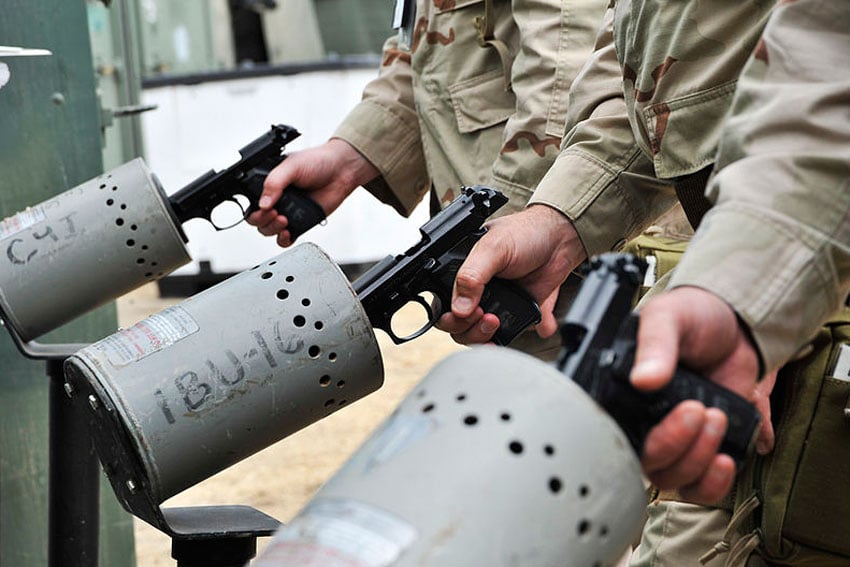
Editor-in-Chief’s Note: Please join us in welcoming back former Navy SEAL and current Director of Training at Center Mass Group, Chris Sajnog as a contributor on ITS Tactical.
I know, I know – A title like, Train Like a S.E.A.L. (Safe Effective Ammoless LearningTM) is a little cheesy. OK, its very cheesy, but I wanted to get your attention and I knew if I used the more common name for this training technique I would guess about half of you would’ve never started reading. Besides, it’s a pretty cool acronym I came up with to better describe one of the most effective firearms training techniques you can use; plus, it doesn’t sound like such a dry topic. You still with me?
Train Like It’s Your Job
Before I retired from the SEAL Teams in 2009, it was my job to practice shooting and teach others how to become expert marksman and Snipers. Finding time to train was never a problem; finding time to have a family was. But now that I’m retired and my only missions are to stop for milk and eggs on the way home, the tables have turned.
Don’t get me wrong, I made the right choice and I’m happy to be home with my family, but finding time to train can be really tough when most of my free time is taken up with checking items off the honey-do list. If any of this sounds like you, don’t worry, I’m going to teach you how you can train to become a better shooter in the comfort of your own home and even save money along the way by learning to dry fire.
Dry Fire
Dry fire seems to be a topic people have a definite and often negative mindset about. Some people think that dry fire is worthless, while others wrongly think they know all there is to know about it, just because they know what the term means. Some people dry fire every day, while others know they should, but don’t like hearing it. Dry fire doesn’t have to be a bad word.
I recently wrote another article about dry fire for my friend and fellow SEAL, Joel Lambert. In it I shoot down some of the biggest myths that are common when it comes to dry fire and explain how it works to make you a better shooter. But one of those myths is that dry fire just means pulling a trigger. Maybe it’s me that’s has it wrong and dry fire does just mean the single act of pulling a trigger, which is fine, I’ve been wrong before (just don’t tell anyone).
The point is, the name doesn’t matter. Call it dry fire, dry weapons manipulation, practicing without actually shooting or my new favorite: Safe Effective Ammoless LearningTM – I don’t really care. The important take away is that you can learn how to shoot and advance your skills very quickly if you use scientifically proven methods to train. This means dry fire.
So this article is for those who are ready to dry fire, but aren’t sure how to get started or want to make sure you’re doing it safely and effectively. Make sure you read through the entire article before you start, but after that, no more excuses!
Live fire only confirms how much dry training you’ve conducted and bullets will only magnify your errors.
Right Tool For the Job
When you do your dry fire training you want to use the right tool for the job. For instance, you should try to use your real gun and magazines for drills that are working on actual manipulation of the weapon. If you are practicing skills that are not focused on weapon manipulation, use other tools such as Airsoft, SIRT pistols, Laser targets or Blue guns to get the most out of the training and make it more interesting. Always figure out exactly what you are practicing and use the best tool for the job.
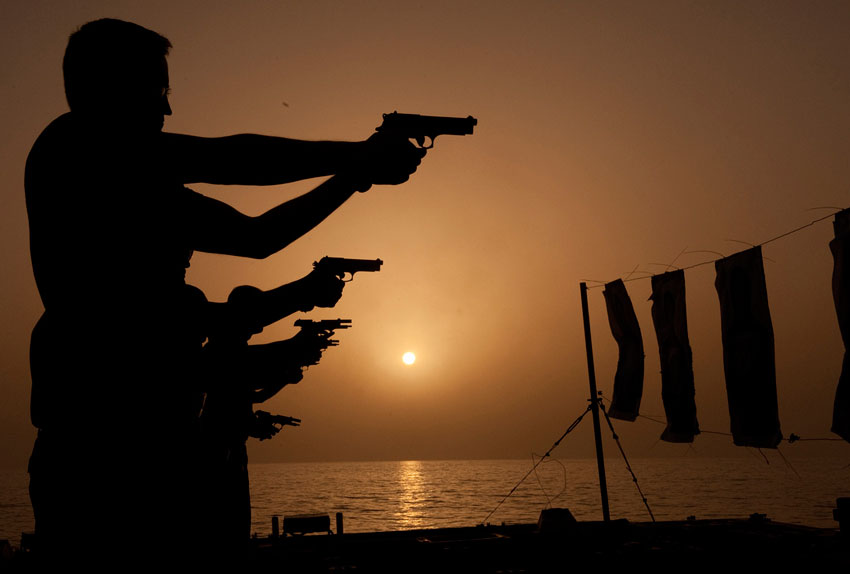
Safety Tips and Guidelines:
- Make sure you have been trained by a professional firearms instructor on firearms safety and how to use your firearm. There are no articles or YouTube videos that can replace professional instruction.
- Dry fire with someone watching you – especially when you’re first learning. The reason for this is that they can watch your technique to make sure you’re doing it right. The only thing worse than not practicing is practicing bad techniques and reinforcing bad habits. Once you’ve got your technique down, it’s fine to practice on your own.
- Although you can dry fire nearly anywhere, pick a place and make it your regular training area. Find a place you can train without distractions such as a bedroom or garage. If you’re at home, go in a room by yourself and shut the door. If others are around or you are at the range, make sure you observe all the normal range safety rules.
- Turn off the TV, radio, computer, iPod, cell phone and any other device that could conceivably distract you.
- Clear the gun, magazines and any equipment you’ll be using of all live ammunition and put it in another room or secure it inside a container.
- If you’re practicing with real firearms make sure that you’re not dry firing at an interior wall that a bullet could pass through. An interior wall with an outer brick wall on the opposite side or a stone fireplace should work fine. I have a friend who uses a cardboard target with a Kevlar vest behind it; not a bad idea. Never under any circumstances dry fire at anything you do not want to destroy! This includes people, pets, the TV, or anything else you value. Other than being unsafe and irresponsible, you could be charged with a felony in the event of an accident. If there is nothing in your house at which you can safely dry fire, don’t dry fire at home. Even if the only safe place you can do it safely is at the range, that’s what you should do. (I make my students dry fire every day at the range before we go hot because it’s a great way to get warmed-up.)
- You should never dry fire if you are tired, distracted, or your mind is on anything other than your practice time. Don’t burn yourself out. Before you get tired of training or start losing concentration – stop.
- If you are ever interrupted, do all your safety checks again.
- Be very careful when you go from live to dry or dry back to live fire with your firearm. This is the time when accidents happen most.
If you have ammunition in your gun and you accidentally fire a round through your wall, you did not have an negligent discharge while dry firing. When you are dry firing, by definition, there is no ammunition in the gun so you were not dry firing. Safety is the most important part of any firearms training, including dry fire.
- And it should go without saying … GUNS, CHILDREN (Untrained/Monitored), DRUGS OR ALCOHOL DO NOT MIX!
Simple Steps to Dry Fire Training:
- Come up with a plan of what you’re going to practice. This should be written down in your range book as well so you can review what you need to work on. You do have a range book, don’t you?
- Visualize yourself doing the techniques perfectly before you begin.
- Review your range book and the fundamentals of marksmanship.
- Get into position and check your gun again. Be absolutely sure the chamber and magazine well are clear! Check your magazines and any equipment you are wearing or using to ensure they are clear as well.
- Say to yourself, “I’m beginning dry fire practice.” Then mentally prepare yourself.
- Go through the list of techniques you need to work on. If you make a mistake, go back and correct it right away to make sure you’re not practicing bad habits. If you do it wrong once, you need to do it right many more times to erase that training scar. Continuous feedback is one of the most important parts of training to help avoid reinforcing bad habits.
- Video your dry fire drills to diagnose your own problems. An iPhone video set on slo-mo is an amazing training tool.
- Train in front of a mirror to work on a smooth draw or magazine changes – this also helps at learning to keep your head up.
- To keep it interesting and to advance your skills you need to vary your practice routines. Start with slow, step-by-step presentation. ”You will do it by the numbers!” Make them perfect and then gradually speed up and smooth it out. If you’ve been taught a four-point presentation with the pistol for instance, remember those points are not destinations but waypoints that you should smoothly move towards and through. Speed can’t be forced, speed happens.
- Your sessions should last from 15 – 20 minutes and you should stop practicing before you get tired or if you get distracted, as you tend to get sloppy in your techniques and build bad habits.
- I recommend for the first two weeks, that you practice every day. For the next two weeks, practice two to three times a week and after that, practice at least one or two times a week to maintain your skills. If you have the time and want to train more often after that, great! Just don’t feel you need to be constantly practicing, as this can seem overwhelming and become an obstacle to training.
- When you’re done, put the gun away in a safe place in your desired carry condition. If you’ve loaded your gun, make sure you say, “My gun is loaded.” at least three times out loud so there is no chance you’ll forget you’re done dry firing.
- Make sure you log your progress in your range book and write down the things you need to work on. Then go on with life until your next dry fire session.
What Do I Actually Do to Dry Fire?
This is the easy part – Work on everything! Ok, if you still think dry fire just means pulling a trigger, then don’t call it that and just start doing some firearms training without loading your gun! Think about all the other parts of shooting: target ID, grip, shooting positions, barricades, shooting while moving, picking up your sights, clearing malfunctions. It really is everything except picking up brass and cleaning guns.
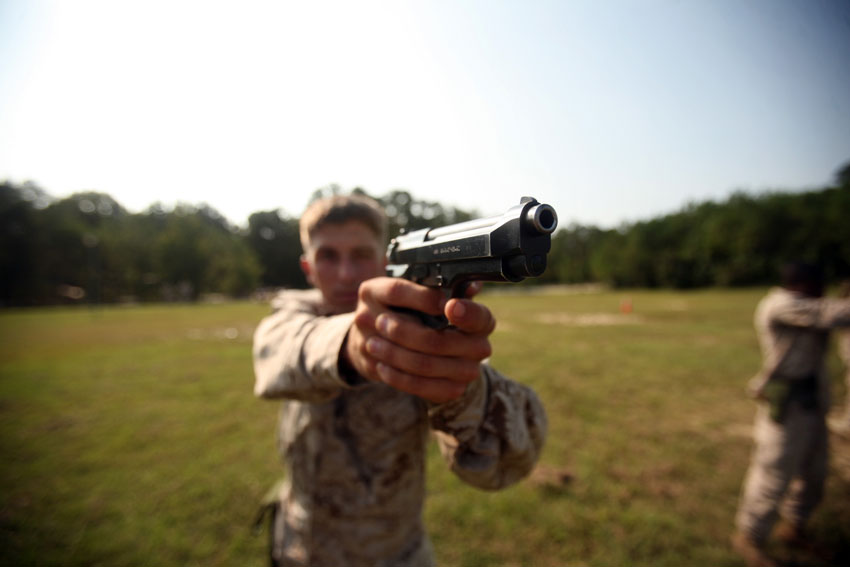
Still Stuck? Here are 77 Ideas:
To help you pick the right tool for the job, I put a B, L, A and/or R next to each for Blue gun, Laser trainer, Airsoft or Real gun. These recommendations can also change depending on several factors including the quality of your Airsoft weapon or whether you’re using a SIRT pistol or a laser cartridge in your real firearm.
Pistol:
- Shooting while moving (BLAR)
- Forward
- Back
- Left
- Right
- Oblique’s
- Shooting with both eyes open/picking up front sight (LAR)
- Acquiring multiple targets (LAR)
- Drawing (R)
- Standing
- Sitting
- Walking
- With reaction-hand only
- Magazine changes (R)
- Slide-Lock
- Tactical
- Kneeling
- Prone
- With strong-hand only
- Reaction-hand only
- Strong-hand, unsupported (LAR)
- Reaction-hand, unsupported (LAR)
- Immediate/remedial action drills (Dummy rounds are great for this) (R)
- Failure to Feed
- Failure to go into battery
- Stove-Pipe
- Double feed
- Barricades (BLAR)
- Turning (BLAR)
- Left
- Right
- 180
- Shooting positions (BLAR)
- Standing
- Squatting
- Kneeling
- Sitting
- Prone
- Supine
- Urban Prone
- Fetal Prone
- 360˚ Scan and assess (BLAR)
- Manipulating light(s) (LAR)
- Mounted
- Hand-held
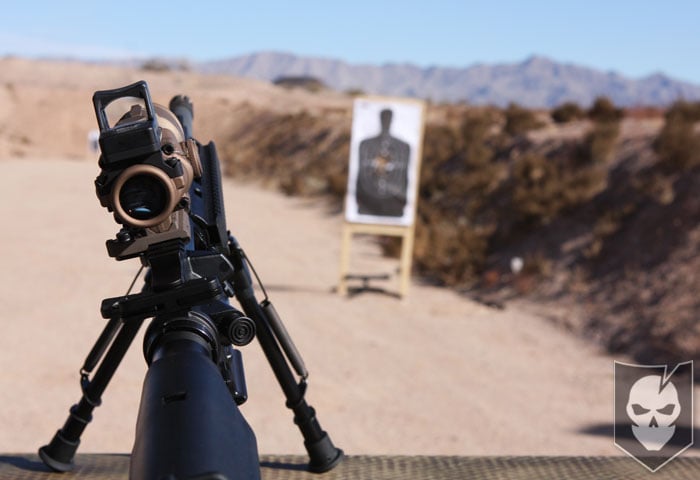
Carbine:
- Finding natural point-of-aim (BLAR)
- Picking up sight from low-ready (EO/Iron) (LAR)
- Picking up sight from high-ready (EO/Iron) (LAR)
- Picking up sight from high-port (EO/Iron) (LAR)
- Shooting positions (BLAR)
- Standing
- Squatting
- Kneeling
- Sitting
- Prone
- Supine
- Urban Prone
- Fetal Prone
- SBU
- Barricades BLAR
- Acquiring multiple targets LAR
- Magazine changes R
- Combat/Speed
- Tactical Reloads
- One-handed
- Immediate/Remedial action drills R
- Failure to Feed
- Failure to go into battery
- Stove-Pipe
- Double feed
- Bolt override
- Transitions B (carbine)
- To pistol R
- To hands
- To reaction side BLAR
- One-handed shooting LAR
- Shooting while moving BLAR
- Forward
- Back
- Left
- Right
- Oblique’s
- Side-step
- Both shoulders
- 360˚ Scan and assess BLAR
- Manipulating light(s) LAR
- Mounted
- Hand-held light
This is in no-way a complete list. I specifically left out many drills that could be added if you included pulling the trigger. Why? Because so many people think that is all you can do during “dry fire,” but now you know better. There are a ton of great drills you can do, but the two most important things you can do are to start and to get constant feedback. Using laser and pro-timers set on par-timer will make it more fun as well as give you other forms of feedback.
In the end, training like a S.E.A.L. is easy (as long as your version of easy involves years of hard work). We’re not born with special powers and it can’t be programmed into you like Neo in the Matrix. If you’ve never dry fired before or don’t do it enough, the results from dry fire training will be dramatic and almost instantaneous. Go ahead and do it for one month, take the 30-day challenge, I dare you! You’re officially out of excuses.
You can download my list of dry fire training tools here.
Do you dry fire? If so, what are your favorite drills? If not, why?
Editor-in-Chief’s Note: Chris is a former Navy SEAL and the Director of Training for Center Mass Group, which was founded by two retired Navy SEAL Instructors. Giving people the experience of being trained by the most elite combat unit in the world, Chris is currently a Maritime-Counter-Terrorism and advanced marksmanship Instructor who has trained DOD, DHS, FBI, CIA and multiple foreign allies in all aspects of combat weapons handling, marksmanship and Maritime Operations.






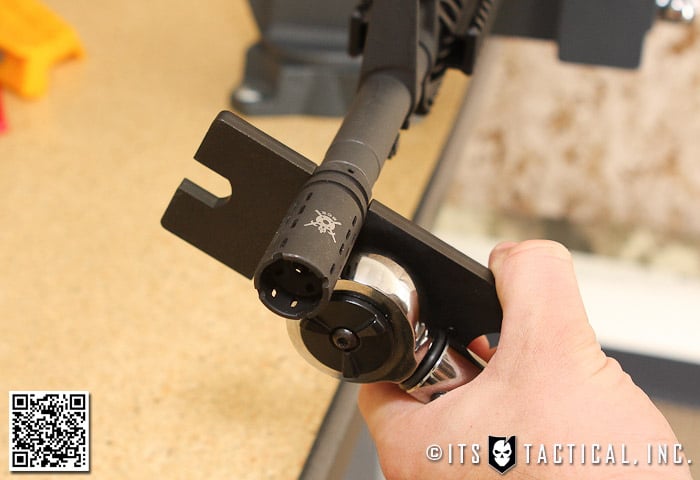
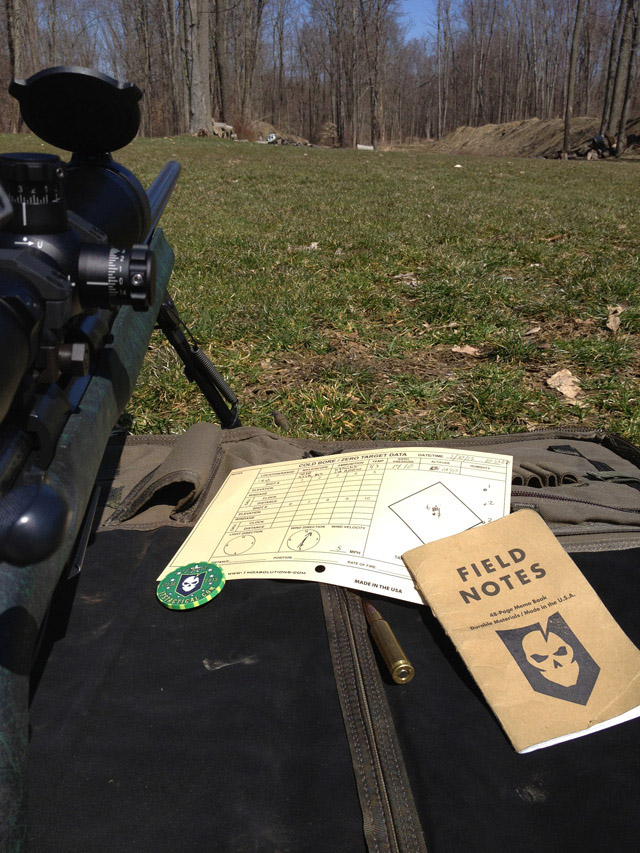
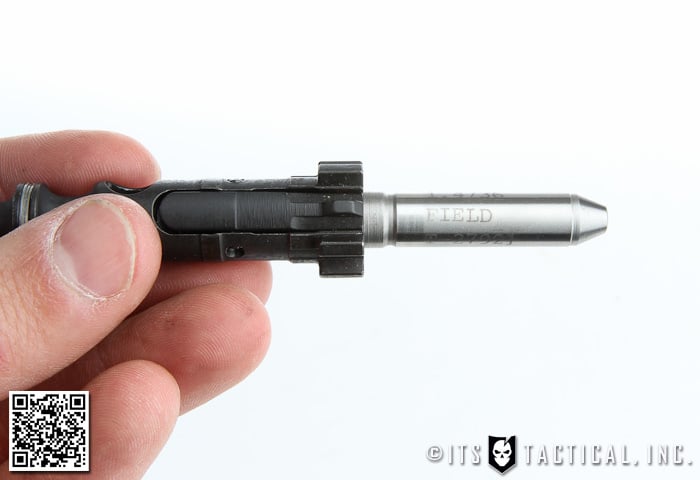
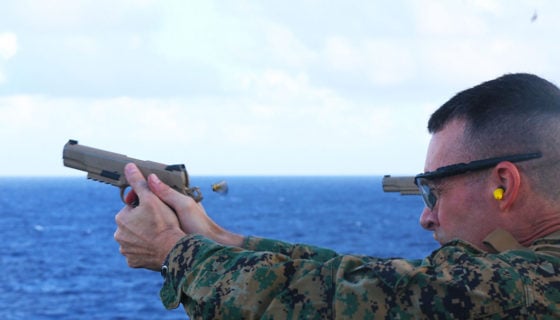

Discussion